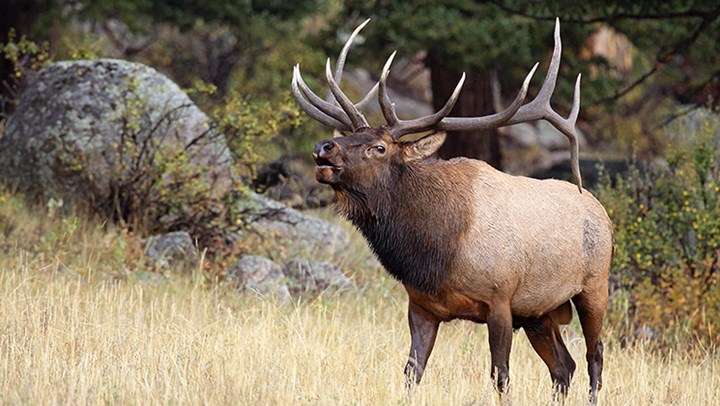
by Phil Phillips - Thursday, July 26, 2018

“Virginia is for Lovers” has been the Commonwealth of Virginia’s iconic tourism slogan for nearly 50 years. Now, thanks to American hunters and their generous contributions of both volunteer time and money, it soon may be for elk. Over the past two months, there are increasing reports tracking how elk numbers are expanding in southwest Virginia as many residents report seeing elk in their home state for the first time.
Since 2012, the Rocky Mountain Elk Foundation (RMEF) has focused heavily on successful elk reintroductions in both Virginia and neighboring West Virginia. The RMEF’s Virginia Elk Restoration Project has been a collaborative effort with the Virginia Department of Game and Inland Fisheries (VDGIF) to bring elk, which were once native to Virginia, back to the state from which they’d all but disappeared by the 1850s. The VDGIF is overseeing the elk restoration project focused on establishing a sustainable elk herd in the southwest part of the state. The agency released 16 collared elk on reclaimed coal-mining land in Buchanan County in 2012, 10 more in 2013 and an additional 45 in April 2014 when Leon Boyd, chairman of RMEF’s Southwest Virginia Coalfields chapter, explained the state’s goal was ultimately to maintain a herd of about 400 animals. At the time, chronic wasting disease (CWD), which has affected elk out West, was a reason some residents opposed the restoration project. Fortunately, CWD never showed up in the herd established on reclaimed mining sites in eastern Kentucky in the 1990s, a state that today has 15,000-plus elk. The habitat in Kentucky is similar to that in the coal-producing area of Virginia. Though previous attempts to restore elk in the state through the years did not work, Virginia elk seem to be thriving this time around. Virginia’s official restoration area now spans 800,000 areas in Buchanan, Dickenson and Wise counties. As noted by the VDGIF, restoring and maintaining elk populations provides ecological, social and economic benefits. If Virginia continues down the path to success, hunters will be front and center in maintaining the herd.
So in getting back to Virginia slogans and nicknames, whether you call the state “Old Dominion” or “Mother of U.S. Presidents,” considering it has produced eight of them, Virginia hunters and non-hunters like say let it also be known for elk.
A Historical Perspective: Tracking Virginia’s Elk Herd
According to sources including VirginiaPlaces.org, the last elk in Virginia was killed in Clarke County before the Civil War. For nearly 60 years, no elk lived naturally in the state. Elk also did not survive in neighboring states so there was no natural migration back into Virginia. Reintroducing elk required capturing the animals west of the Mississippi River and shipping them east.
Between 1913 and 1922, elk were brought in and released in Augusta, Bath, Botetourt, Cumberland, Giles, Montgomery, Princess Anne, Pulaski, Roanoke, Rockbridge, Rockingham, Russell, Warren and Washington counties. Most releases occurred in 1917 when 125 Rocky Mountain elk were introduced from Yellowstone National Park. The elk released near Cape Henry soon came across the local vegetable farms, so the herd in Princess Anne County (now the City of Virginia Beach) was destroyed soon after its release. By 1922, there were none left in Cumberland County either, but elk did expand their range into Bland, Craig and Bedford counties. By contrast, as far back as the 1600's elk grazed in the summer on mountain ridges and in the winter in the valley bottoms, making long-distance migration unnecessary. By the 1900's, however, the habitat on the ridges was still available, but the valley bottoms were being converted into farm and ranch ground. The lack of winter grazing habitat and excessive poaching led to the disappearance of most of the elk that had been imported by the Virginia Game Commission (now the VDGIF).
Taking Pride in Hunting: Hunters’ Dollars at Work
In telling the story of hunters and hunting, we stewards of wildlife have much to be proud of as the United States maintains the most successful wildlife management system worldwide. Known as the North American Model of Wildlife Conservation, the system, by the way, was adopted as NRA policy in December 2014, thanks to a suggestion by NRA First Vice President and race car hall-of famer Richard Childress. Hunters and anglers have paid more into this system than any other group of outdoor enthusiasts. Whether through hunters’ license, tag and permit fees; voluntary donations we make to habitat projects; or membership fees to like-minded hunting and wildlife conservation organizations like the NRA and RMEF, our dollars fund wildlife conservation so wildlife continues to thrive.
Just look at elk numbers alone. In 1907 only 41,000 elk remained in North America. A century later, thanks to hunters’ dedication to restoring and conserving habitat, wildlife biologists now report elk numbers in excess of one million. For another bonus, the money we pay for habitat, research and wildlife law enforcement aids game and non-game species alike. Of course, in addition to funding conservation, American hunters certainly do their share in pumping money into economy as the RMEF reminds us that hunting also generates $38 billion a year in retail spending. And this doesn’t account for the more than $1 billion a year that the U.S. Fish and Wildlife Service distributes to state wildlife agencies each year specifically for conservation, outdoor recreation and job creation—all thanks to American sportsmen.
Share these great facts with non-hunters and help them to understand that hunting is conservation. While you’re at it, throw in the fact that in 1937 hunters actually requested an 11 percent tax on guns, ammunition, bows and arrows through the Pittman-Robertson Act to help fund conservation—a tax that to date has raised more than $8 billion nationwide for wildlife conservation.
E-mail your comments/questions about this site to:
[email protected]
